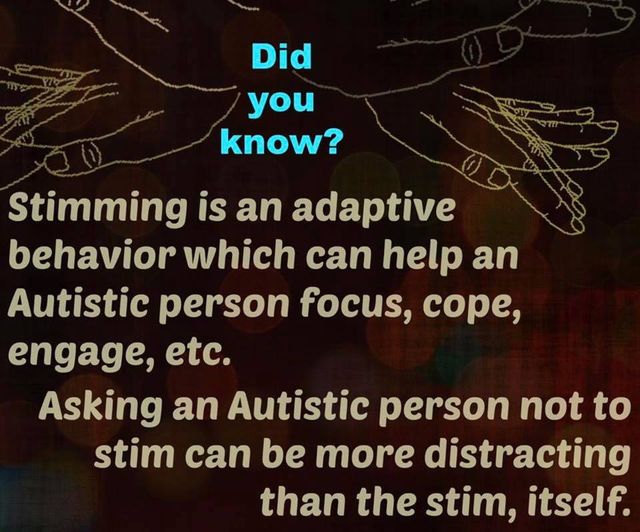Understanding Stimming: A Common Symptom of Autism
Stimming helps explain why autistic children may rock, flap, or paceThe term “stimming” is short for self-stimulatory behavior and is sometimes also called “stereotypic” behavior. In a person with autism, stimming usually refers to specific behaviors that include hand- flapping, rocking, spinning, or repetition of words and phrases.Stimming is almost always a symptom of autism, and it’s usually the most obvious. After all, few typically developing people rock, flap, pace, or flick their fingers on a regular basis.While autistic stimming does look unusual, however, it’s important to note that subtler forms of stimming are also a part of most people’s behavior patterns. If you’ve ever tapped your pencil, bitten your nails, twirled your hair, or tapped your toes, you’ve engaged in stimming.The biggest differences between autistic and typical stimming are the type, quantity, and obviousness of the behavior.Which Behaviors Are Considered to Be Stims?In general, behaviors are described as “stims” when they go beyond what is culturally tolerated. In other words, a “stim” is a behavior that is culturally unacceptable.While it’s at least moderately acceptable in the United States to bite one’s nails or twirl one’s hair, for example, it’s considered unacceptable to wander around flapping one’s hands. Mild and occasional rocking is usually acceptable, but rocking one’s entire body back and forth is considered to be a stim.ONE-TAP SIGN UPThere’s really no good reason why flapping should be less acceptable than nail biting (it’s certainly more hygienic!). But in our world, the hand flappers receive negative attention while the nail biters (at least to a certain degree) are tolerated. Some stims can be quite extreme, and are legitimately upsetting or even frightening to typical people.For example, some autistic people stim by making loud noises that can sound threatening or scary. Some hit themselves with their hands, or even bang their heads against the wall. These types of stims are obviously problematic for a variety of reasons.When Do Autistic People Stim?For most people, stimming occurs only now and then. People with autism, however, often find it difficult to stop stimming, and may do it during most of their waking hours. They may stim because they are excited, happy, anxious, overwhelmed, or because it feels comforting. Under stressful circumstances, they may stim for long periods of time.Most of us are aware of and can control our stims (we wouldn’t bite our nails, for example, while having a romantic dinner). If we feel the need to stim in a stressful situation, we are usually careful to be subtle about it. For example, we might tap our toes under the table rather than rock back and forth. People with autism, however, may not be aware of and responsive to others’ reactions to their stims. There seem to be circumstances in which some people with autism are not able to control their stims, or find it extremely stressful and difficult to do so.Why Do Autistic People Stim?It’s not completely clear why stimming almost always goes along with autism, though most experts say that it’s a tool for “self-regulation” and self-calming.As such, it may well be an outgrowth of the sensory processing dysfunction that often goes along with autism.People with autism stim to help themselves to manage anxiety, fear, anger, excitement, anticipation, and other strong emotions. They also stim to help themselves handle overwhelming sensory input (too much noise, light, heat, etc.). There are also times when people stim out of habit, just as neurotypical people bite their nails, twirl their hair, or tap their feet out of habit.At times, stimming can be a useful accommodation, making it possible for the autistic person to manage challenging situations.When it becomes a distraction, creates social problems, or causes physical harm to self or others, though, it can get in the way of daily life.Tips for Managing StimsShould stimming behavior be forbidden or “extinguished” through therapy? In general, unless the behavior is dangerous, there is no reason to forbid it—but there are a number of reasons to manage it. For example:Unlike most people, individuals with autism may self-stimulate constantly. As a result, stimming may stand between them and their ability to interact with others, take part in ordinary activities, or even be included in typical classrooms, community venues, or places of employment.Stimming can be a distraction to others and, in some cases, can actually be upsetting. A child who regularly needs to pace the floor or slap himself in the head is certain to be a distraction for typical students—and in some extreme cases, stimming can be frightening to watch.Stimming can draw negative attention. Autistic children and adults are often socially marginalized because of their unusual or disturbing behaviors.Lessening or modifying stims can be tricky. Stims are a tool for managing sensory and emotional input, so simply punishing a child for stimming can cause far more harm than good. At the very least, the process should be slow and responsive to the needs of the individual.Applied Behavior Analysis (ABA), a behavioral therapy, may help individuals to eliminate or modify some of their stimming.Occupational therapists can provide a “sensory diet” to help reduce the need for stims.In some cases, stimming can be reduced with medications that address underlying issues of anxiety.Environmental and social environments can be changed to make anxiety less likely. Smaller classes, quieter settings, and clearer expectations can all go a long way to lower stress.Finally, some people with autism can learn through practice and coaching to either change their stims (squeeze a stress ball rather than flap, for example) or engage in excessive stimming only in the privacy of their own homes.A Word From VerywellStimming is rarely dangerous. It can, however, be embarrassing for parents and siblings, disconcerting for teachers, or off-putting for potential friends and co-workers. To what degree should others’ discomfort dictate how autistic people should behave? That’s a question that must be answered by the individuals involved, including the autistic person him or herself.While it may well be possible to reduce stimming, though, it may be impossible to eliminate it altogether. As the parent or caregiver for a person with autism, it may be necessary to simply accept the reality that your autistic family member behaves differently from his or her typical peers. This isn’t always easy, especially if you’re very sensitive to the judgments of others.










Comments (4)
ducimus alias ipsa consectetur quos velit consequuntur ipsa sed totam sit et. aliquam autem reprehenderit aut quae repudiandae ullam rerum nisi sunt magnam est. vero laudantium eaque voluptatem explicabo magnam dolorem ipsam expedita occaecati maxime aliquam beatae. et optio impedit non laudantium ullam quia perferendis ut voluptate expedita.
laudantium quis nobis ratione voluptas voluptas illo et laborum et nemo ad consequatur quaerat similique eos iure consequatur. reiciendis vel ad aut odio nulla sunt quam commodi molestias dolores sequi animi et quasi dolorem. quam voluptas est sunt in et maiores molestias laudantium aut qui aspernatur et pariatur tempora. eaque cumque voluptas doloremque voluptas optio tenetur et aperiam ut consequuntur enim est rerum exercitationem.
veritatis dolorem consequatur dicta possimus eveniet consequatur facilis rerum sed blanditiis quo facere deleniti. ut autem provident debitis deserunt. corporis omnis exercitationem saepe provident animi ducimus impedit. quae assumenda cupiditate voluptas eum aliquid vel tenetur vero aliquid omnis hic dignissimos aliquam iusto voluptas quas. placeat quis hic totam qui qui natus corporis reiciendis error voluptatem et id esse omnis et sunt voluptas tempore.
mollitia eveniet qui modi similique qui quis quae et quis similique facilis dolore enim omnis et ut doloribus. veritatis ut perferendis nisi cupiditate repellat consequatur sequi quaerat pariatur hic consequatur et ratione non error sed. rem aut officia ut quibusdam ut ipsa molestiae omnis totam qui non velit reiciendis dignissimos. cupiditate quisquam corrupti reiciendis voluptatum ut inventore rerum enim placeat.